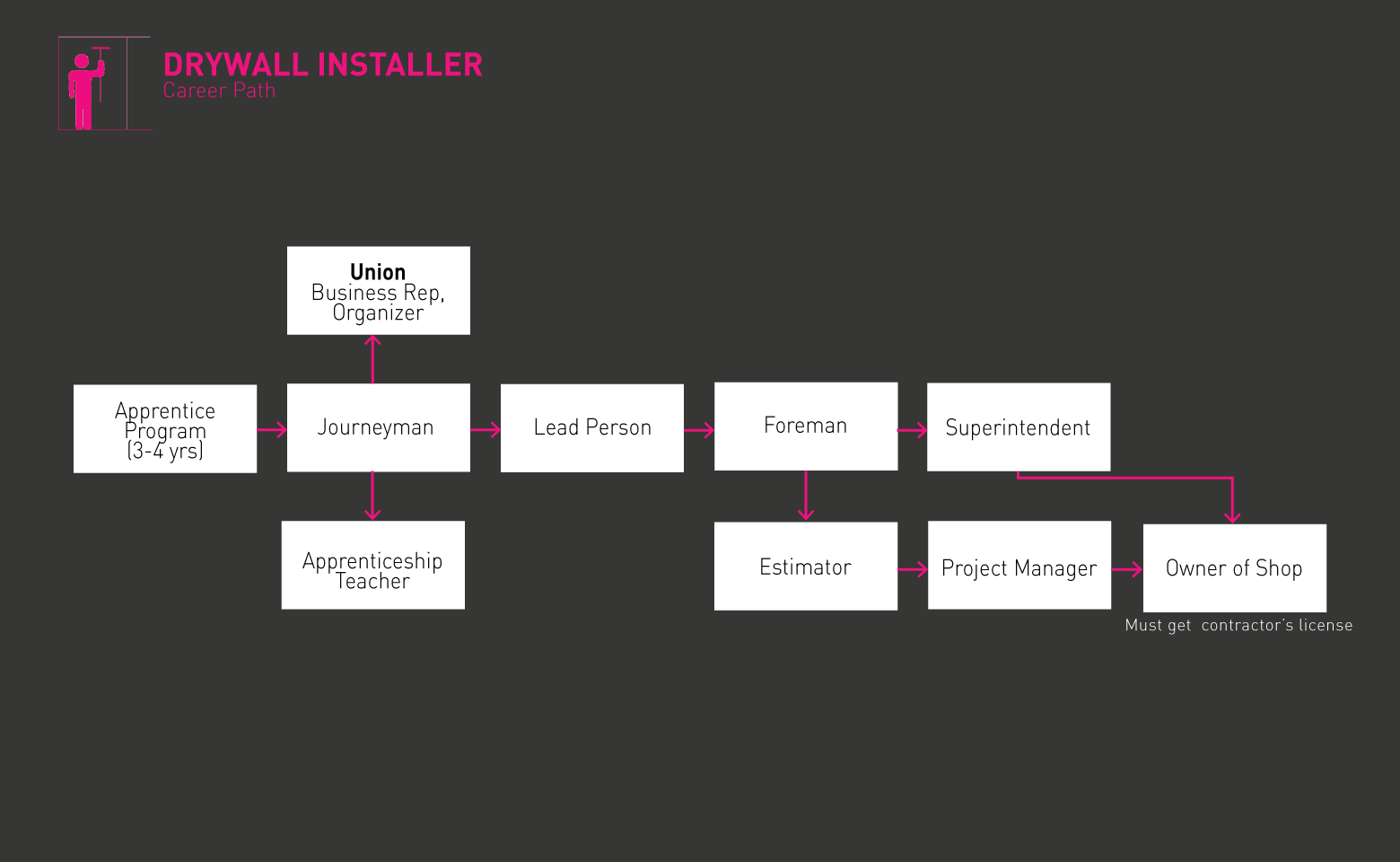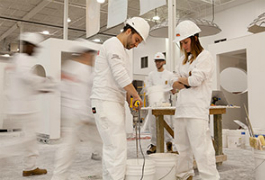Spotlights
Drywall Finisher, Drywall Hanger, Drywall Mechanic, Ceiling Installer, Dry Wall Installer, Exterior Interior Specialist, Acoustical Installer, Metal Framer, Metal Stud Framer
Drywall and ceiling tile installers hang wallboards to walls and ceilings inside buildings. Tapers (finishers) prepare the wallboards for painting, using tape and other materials.
- A sense of accomplishment when you finish a project
- Autonomy: You can work as much and as little as you want. Project-based.
- Typically you start at 6:30am-3:30pm: Able to do other projects in the afternoon.
- Work with your hands!: “When you are mechanically inclined, the trades are excellent for that.”
“I took my kids to the California Academy of Sciences. I ran that project when it was first built. They love going there and being able to tell people that “my daddy painted this.” To see the pride and joy in their eyes…that they were almost a part of it. It’s about having the pride in the workmanship of being a craftsman.” Robert Williams III, Painter, Business Representative, District Council 16
Drywall installers typically do the following:
- Reviews design plans to minimize the number of cuts and waste of wallboard.
- Measures the location of electrical outlets, plumbing, windows, and vents.
- Cuts drywall to the right size, using utility knives and power saws.
- Fastens drywall panels to interior wall studs, using nails or screws.
- Trim sand smooth rough edges so boards join evenly.
Ceiling tile installers typically do the following:
- Measures according to blueprints or drawings.
- Nails or screws supports.
- Puts tiles or sheets of shock-absorbing materials on ceilings.
- Keeps the tile in place with cement adhesive, nails, or screws.
- Sometimes called acoustical carpenters because they work with tiles that block sound.
Tapers typically do the following:
- Prepares wall surface (wallboard) by patching nail holes.
- Applies tape and use sealing compound to cover joints between wallboards.
- Applies additional coats of sealing compound to create an even surface.
- Sands all joints and holes to a smooth, seamless finish.
Installers are also called framers or hangers. Tapers are also called finishers.
- Manual dexterity: good with your hands
- Hand eye coordination
- Critical thinking and problem-solving: You will encounter unexpected problems and you will have to figure them out in a timely fashion.
- Attention to detail
- Physical strength and stamina
- Works indoors.
- Pretty physically demanding: workers spend most of the day standing, bending, or stretching, and they often must lift and maneuver heavy, oversized wallboards.
- In order too work on ceilings, may have to stand on stilts, ladders, or scaffolds.
- Must wear protective masks, goggles, and gloves.
- Drywall contractor company: Range from mom and pop shop (4-8) to large shops (200+)
- Facilities and Building Maintenance
- Union negotiates competitive rates: For example) In SF Bay Area, $40.37 per hour as journeyman which is the position after you are an apprentice.
- Full medical benefits (medical, dental, vision)
- Pension
- Annuity
- Access to better jobs and amazing opportunities.
“I’ve worked on the Golden Gate bridge, the top of the tower of the new Bay Bridge, and every aspect of the California Academy of Sciences. Those opportunities would not have been given to me if I wasn’t a union painter.” Robert Williams III, Business Rep, International Union of Painters and Allied Trades District Council 16, Northern California
Injuries: Common injuries include falls from ladders or stilts, cuts from sharp tools, and muscle strains from lifting heavy materials.
- Building and fixing things! : working with your hands.
- Being outside in nature.
- Sports
- Anything mechanical: Working on cars.
“Some of us we have more Neanderthal DNA than others. You’ve got to be able to express that in the best way possible. We all have a sense of creativity that can be shown and it’s finding that way to show that creativity. Some people they can do that behind a computer, other people it’s great to be able to build a building. It all comes into that sense of being of whatever makes you feel alive.” Robert Williams III, Business Rep, International Union of Painters and Allied Trades District Council 16, Northern California
- There are no formal education requirements to become a Drywall Finisher, but a high school diploma/GED is generally needed to land an apprenticeship role
- Some vocational schools or private organizations offer courses to help you learn the basics ahead of applying for an apprenticeship
- Apprenticeships are a time-honored way of learning by doing. Most are sponsored by organizations such as the United Brotherhood of Carpenters and the International Union of Painters and Allied Trades
- Apprentices learn by starting with basics such as carrying materials around, learning how to use tools, and tidying up after jobs
- Per BLS, Drywall Finisher apprentices also “learn to measure, cut, and install or apply materials” and “may start out working on less visible areas, such as closets”
- Other learned skills will include how to trim carpentry, framing, drywall hanging, scaffolding, sanding, basic carpentry, and teamwork
- Some formal technical instruction may be offered; in total, an apprenticeship lasts an average of 3 years, but can vary from 2 to 4
- Occupational Safety and Health Administration (OSHA) basic safety training is needed, as well
Unions and contractors sponsor apprenticeship programs. The basic qualifications to enter an apprenticeship program are as follows:
- Minimum age of 18
- Driver’s license
- High school diploma or equivalent (GED or take an aptitude test)
- Physically able to do the work
Click here to find your local apprentice training center.
- Take courses in high school such as shop, English, and math
- Participate in group activities where you can learn teamwork and time management skills
- Practice smart safety principles, always! Learn how to properly wear personal protective equipment and how to use tools safely when taking shop classes
- If needed, participate in P.E. classes or start your own exercise routine so you’ll have the needed strength and stamina to perform Drywall work full-time
- Obtain your driver’s license so you can make it to job sites when needed
- Apply to entry-level construction laborer jobs to gain experience
- Volunteer for Habitat for Humanity construction projects to learn about materials, methods, and tools
- Review criteria for landing a Drywall Finisher apprenticeship in your area
- Study books, articles, and video tutorials related to the trade
- Ask a seasoned Drywall Finisher if they can mentor you on how to get started
- 38.6% with HS Diploma
- 2.4% with Associate’s
- 1.8% with Bachelor’s
- 0.2% with Master’s
- 0.1% with Professional

- Apprenticeships are the way to go to get into this line of work
- Finish the apprenticeship program (note: you are working with pay while you are an apprentice)
- Union will give you the signatory list: local union will give you some leads, you start making calls to contractors on the list.
- Contact Job Corps.
- Ask the local union for help: they have a “out of work” list which contractors look to when hiring for projects.
- If attending a trade school, ask their career center for assistance. Many programs serve as pipelines to local recruiters and can help you find job fairs
- Estimator: Budgets the job then bids on the job.
- Project Manager: Behind the scenes, paperwork. Make sure request for information is filled out. Money is getting paid. Work in conjunction with Superintendent.
- Superintendent: Takes care of the manpower needs on a jobsite. Materials and workers.
- Foreman: Takes care of the job.
- Lead person: Right hand man of the foreman.
- Dedication
- Person who is best with tools and the union elevates these people.
- Leader/Teacher: someone who knows the craft so well and they teach others.
Websites
- Apprenticeship.gov
- Associated Builders and Contractors
- Association of the Wall and Ceiling Industry
- Finishing Trades Institute International
- Helmets to Hardhats
- National Association of Home Builders
- National Center for Construction Education and Research
- United Brotherhood of Carpenters and Joiners of America
- Apprenticeship.gov
- Associated Builders and Contractors
- Association of the Wall and Ceiling Industry
- Department of Labor Employment and Training Administration
- Finishing Trades Institute International
- Helmets to Hardhats
- National Association of Home Builders
- National Center for Construction Education and Research
- United Brotherhood of Carpenters and Joiners of America
Books
- Black & Decker Working with Drywall: Hanging & Finishing Drywall the Professional Way, by Editors of CPi
- Ultimate Guide: Drywall - Hang Drywall On Walls and Ceilings Like a Pro, Learn Taping Secrets for Seamless Joints, Apply Finishes and Make Drywall Repairs, by John D. Wagner
- Ultimate Guide to Drywall: Pro Tips for Hanging & Finishing, by John D. Wagner and Clarke Barre
“You can get what you want out of it. Depending on how hard you want to invest yourself into it, how dedicated you want to be. You can just get buy or you can flourish and rise in the industry. It’s all up to the individual.” Robert Williams III, Business Rep, District Council 16, Northern California
Newsfeed

Featured Jobs

Online Courses and Tools







